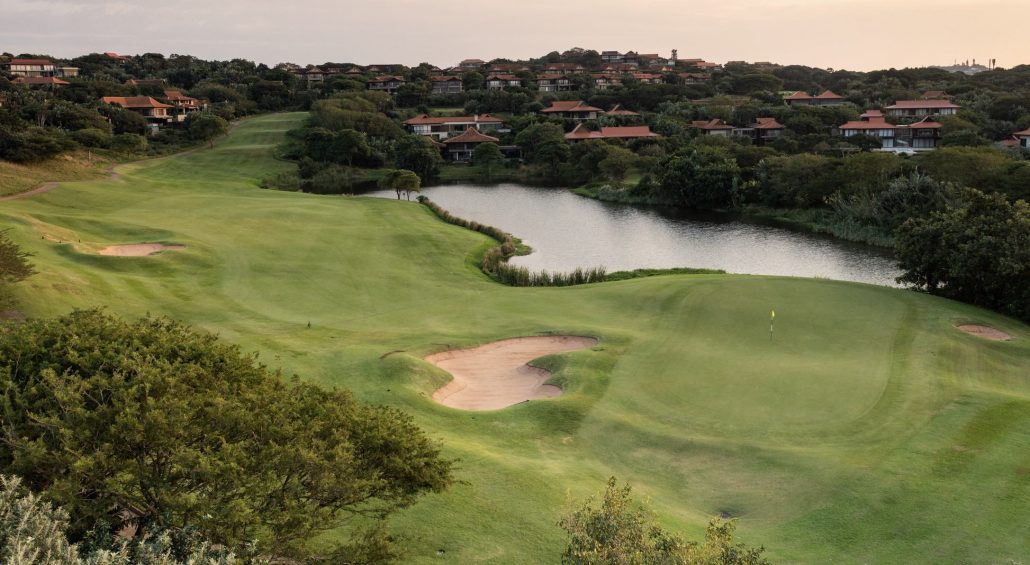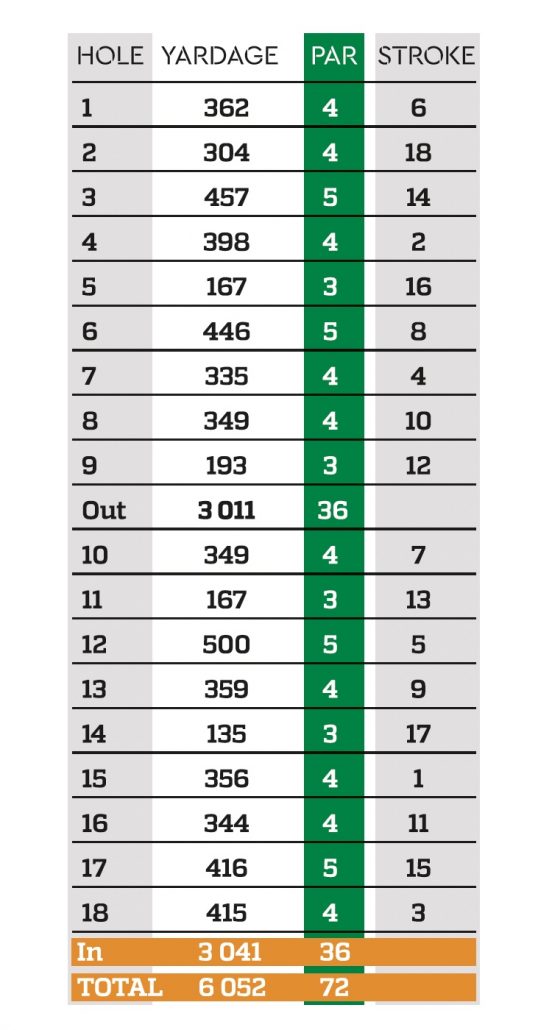Surrounded by sugarcane fields on the one side and the warm Indian Ocean on the other, Zimbali is always a firm favourite, writes MARK SAMPSON.
Located within a secure housing estate about 45 minutes north of the Durban CBD in the Ballito region of KwaZulu-Natal, one can expect warm weather all year round and with that a course that seldom loses condition.
It is one of the 40 courses designed by renowned architect Tom Weiskopf with very little changing on the course since its completion in 1998, with the greens and layout standing the test of time. As it is located on rolling hills, the natural terrain was utilised to form stunning open fairways with strong contouring and numerous changes in elevation from tee to green.
One of the biggest appeals of the course is the open layout set in thick coastal bush abundant in wildlife and birds. Boasting over 200 bird species it is birder’s delight and no birdies on the card will be made up by plenty spotted during the round. Several small antelope, including bushbuck and duiker, are also likely to be seen during the round as well as the ever-inquisitive vervet monkeys.
Within the confines of the 925-acre estate, a 50-hectare reserve allows for nature to be totally unspoilt and plentiful. The layout eases around the estate and one can expect numerous changes in elevation with subtle contouring on large greens. Although surrounded by coastal bush, the layout is very fair allowing for an errant shot without having to continuously reload, which adds to the enjoyment factor immensely.
The course routes out and back on each nine to the large clubhouse. A unique feature of the clubhouse is the old remains of the original farmstead at the very centre of the structure through which a magnificent ficus tree grows (wild fig).
Zimbali, meaning ‘place of flowers’, is a delight to play. Even though you are in the heart of the Ballito area and surrounded by houses and two hotels, it allows for an amazing feeling of complete freedom and being at one with nature. The looping nature of the layout means very few holes pass one another and the thick vegetation truly does make for a complete feeling of isolation and serenity during the round.
The layout is incredibly well balanced with a good variety of reachable par fives, a variety of par fours and a strong quartet of par threes. The 1st is a sliding dogleg right to left. The drive is semi-blind but with a generous fairway it should not pose a real threat. Generous fairways are very much the order of the day with ample secondary rough before the coastal bush is found. At 362m, a mid- to short-iron will be left to a large green. The par-four 2nd is short at only 304m and has a strong drop in elevation. Water on the left side of the entire hole does grab one’s attention off the tee with a fairway bunker right waiting for a pushed drive.
Next up is the first par five of 457m. From the tee one can expect a big drop in elevation, with the fairway then rising
back up to the green with a large bunker front left and another over the back.
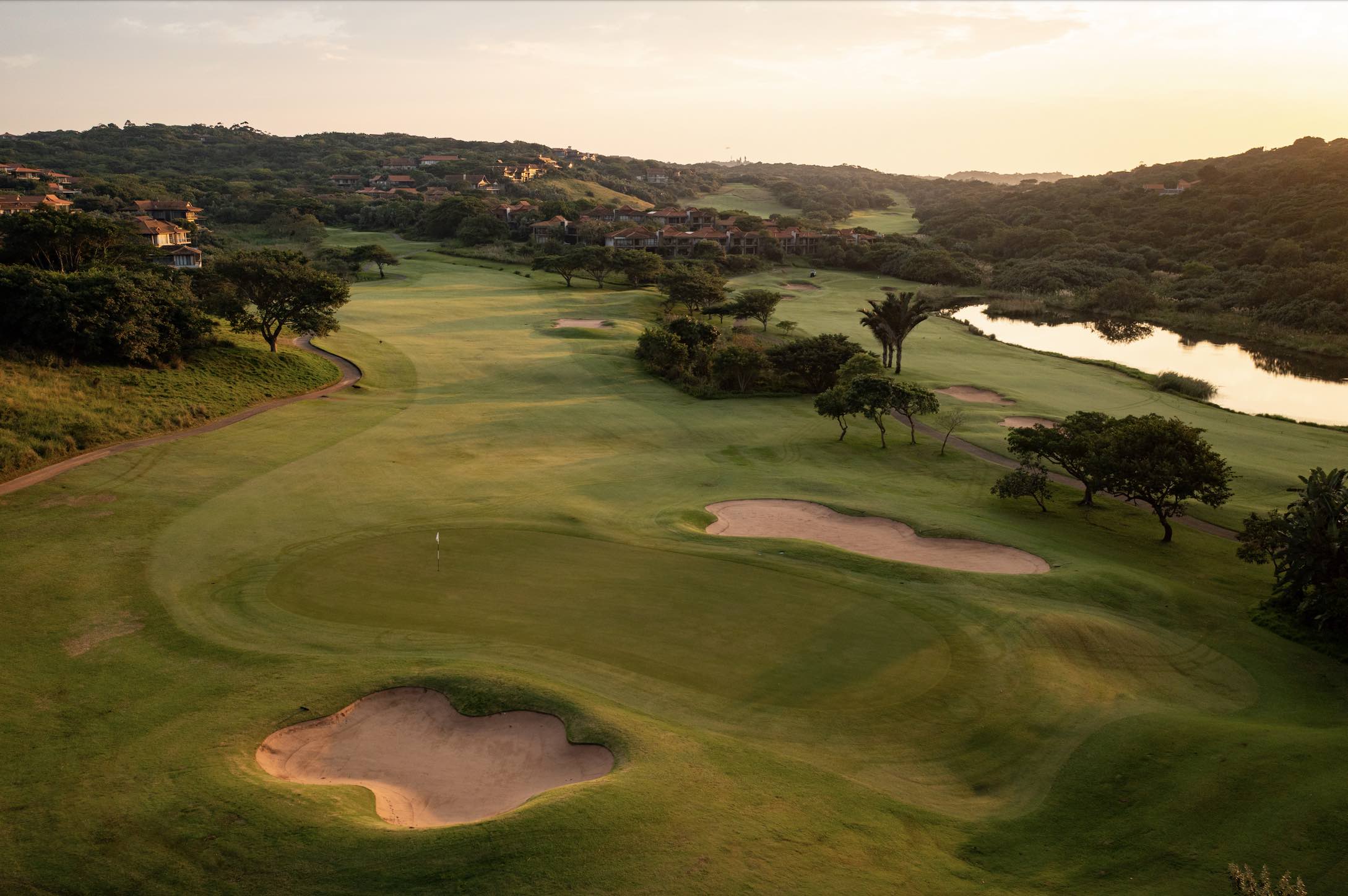
The first par three of the round arrives at the 5th hole. Zimbali’s par threes make for a strong set of shorts, with the 5th being the feature hole of the course.
Turning back toward the clubhouse, next up is a 446m par five with water along its entire right flank. For this reason, favouring the left side of the fairway is advisable, although two fairway bunkers lie in wait for a pulled shot. Having one of the smaller putting surfaces on the course, and with three bunkers, the green makes for a difficult target with long-iron in hand. Being the stroke eight, one would be forgiven for laying up and going for the two-putt par.
The stroke-four 7th is a particularly daunting hole, especially as it generally plays into the prevailing wind. It is not long at 335m, but does play uphill and has one of the more contoured greens on the course. Thick coastal bush right needs to be avoided and left is no bail-out either as numerous mature trees protect it. The fairway pinches at about 100m out so accuracy off the tee, and shrewd club selection, are required. Two bunkers left of the green, with bushes right, make the putting surface a tough target.
The front nine closes with a strong uphill par three. Playing into prevailing wind, the 193m hole requires a well-struck long-iron or more. To add to the spice, two bunkers, left and right, protect the below-average size green. A strong closing hole before the small but well-stocked halfway.
The par-four 10th sets the tone for what is arguably the tougher of the two nines.
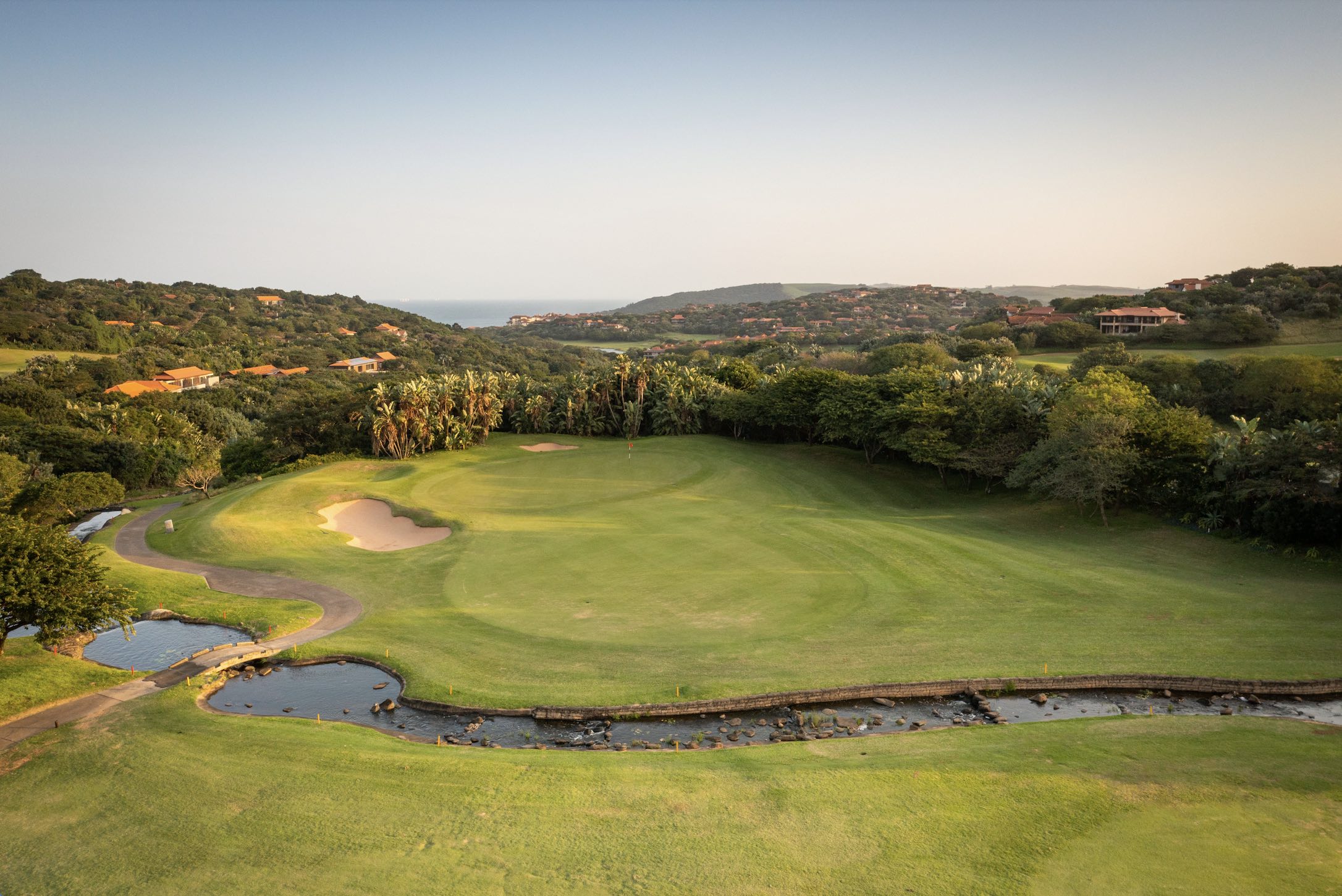
It certainly is a tighter nine with accuracy required as the journey takes one deep into the coastal bush with a number of holes having large drops in elevation from tee to green. At 349m the 10th is not particularly long; however it has a water hazard moving down the right side before cutting across the fairway. Several well-placed fairway bunkers on both sides of the landing zone dictate accuracy or simply taking a lesser club off the tee to avoid them. Greenside, two bunkers protect the green which slopes quite strongly from right to left.
The first major elevation change can be expected at the par-three 11th. Playing 167m from the club tee, at least one club can be taken off for the change in elevation. Water short and three bunkers surround the green.
The 12th is the longest hole on the course and into the prevailing wind this 500m stroke five takes three well-struck shots to reach the green. Another massive drop from tee to fairway can be expected at the par-four 13th.
At only 359m it is not long but if there was an intimidation rating this hole would take first spot, with thick bush left and water hazards down the entire right flank. The strongly sloping fairway can also be somewhat unnerving on the approach.
A diminutive par three of 135m is next up, another big drop from tee to green, and offers some respite before reaching the stroke one. Like many of the par fours it is not long at 356m; however, accuracy is an absolute must from tee to green.
A water hazard needs to be cleared both from the tee and on the approach to the hole. The fairway is not quite as forgiving as previous holes and into the coastal wind this hole will test your swing. The fairway starts pinching approximately 100m out and based on the wind direction club selection can be a challenge.
The final par five of the course comes at the 17th and is a genuine birdie opportunity. A straight fairway with a bunker on the right side means the left side of the fairway should be favoured, with more space left than can be seen from the tee box. At 416m in length, the longer hitters can reach the green in two although it is well protected by four bunkers which can be avoided by aiming for the right side of the green.
The final hole is a par four and only 1m shorter than the previous par five. Sliding from right to left, the hole takes you back to the clubhouse. Although wide, the landing area for the drive, the corner of the dogleg, is well protected by bunkers both left and right. With long-iron in hand the right side of the green should be targeted to avoid the bunker left. A severe slope from the right will also help feed any balls back down onto the green.
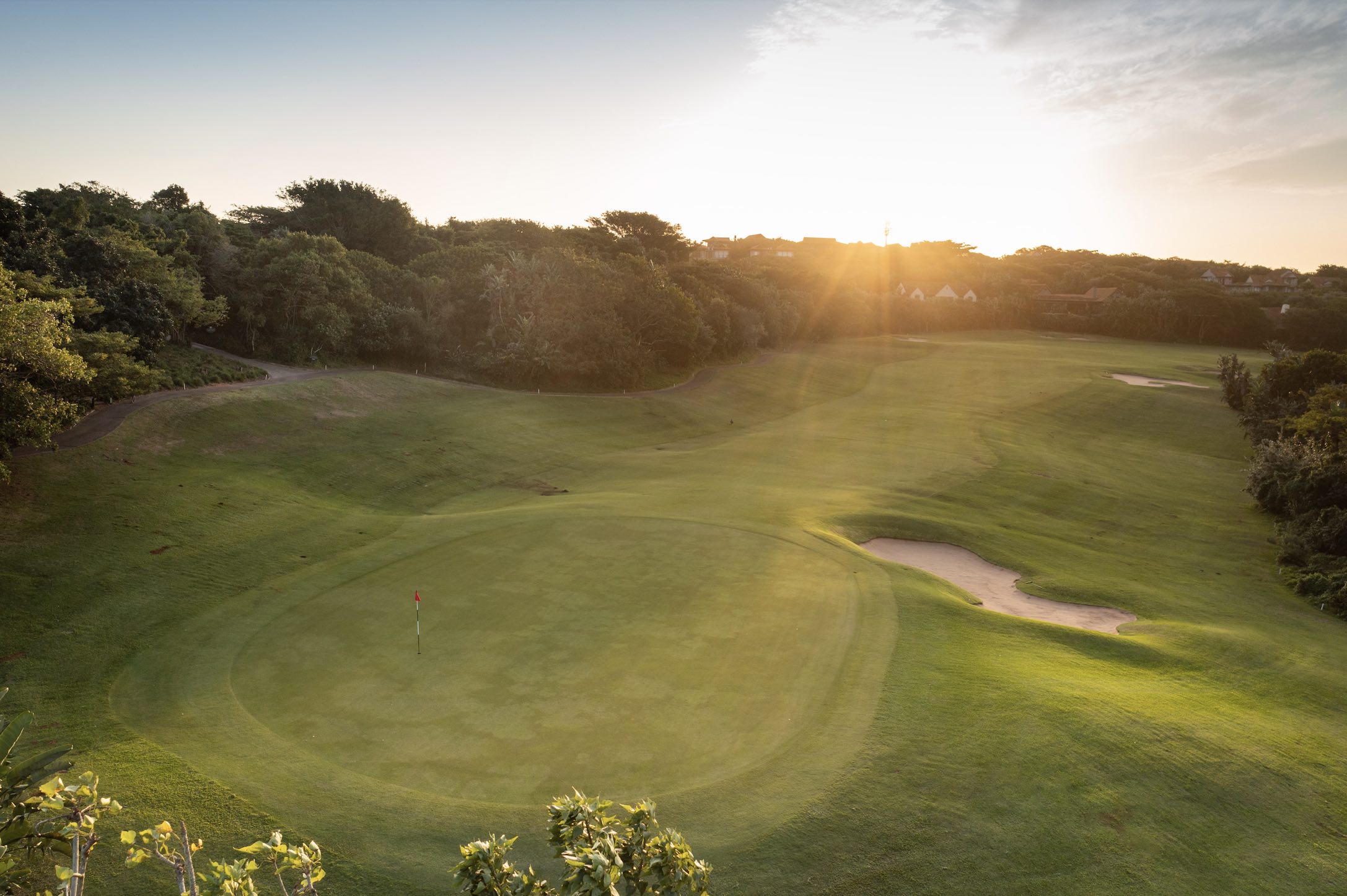
The clubhouse has undergone several upgrades in recent times and has an amazing outdoor area set among the coastal bush and mature trees. Perfect to relax and reflect on the round. It also offers a full menu as well as having a separate restaurant for groups and functions.
The course and facility in general have a timeless feeling about it where nothing really seems to change and the course condition, staff and general experience are constantly the same, superb and effortless, which go hand in hand with the relaxed and isolated feeling a round of golf offers at Zimbali. It is no surprise it is continually ranked in the top 20 in South Africa and No 1 in KwaZulu-Natal.
SIGNATURE HOLE
5th hole, par three, 167m
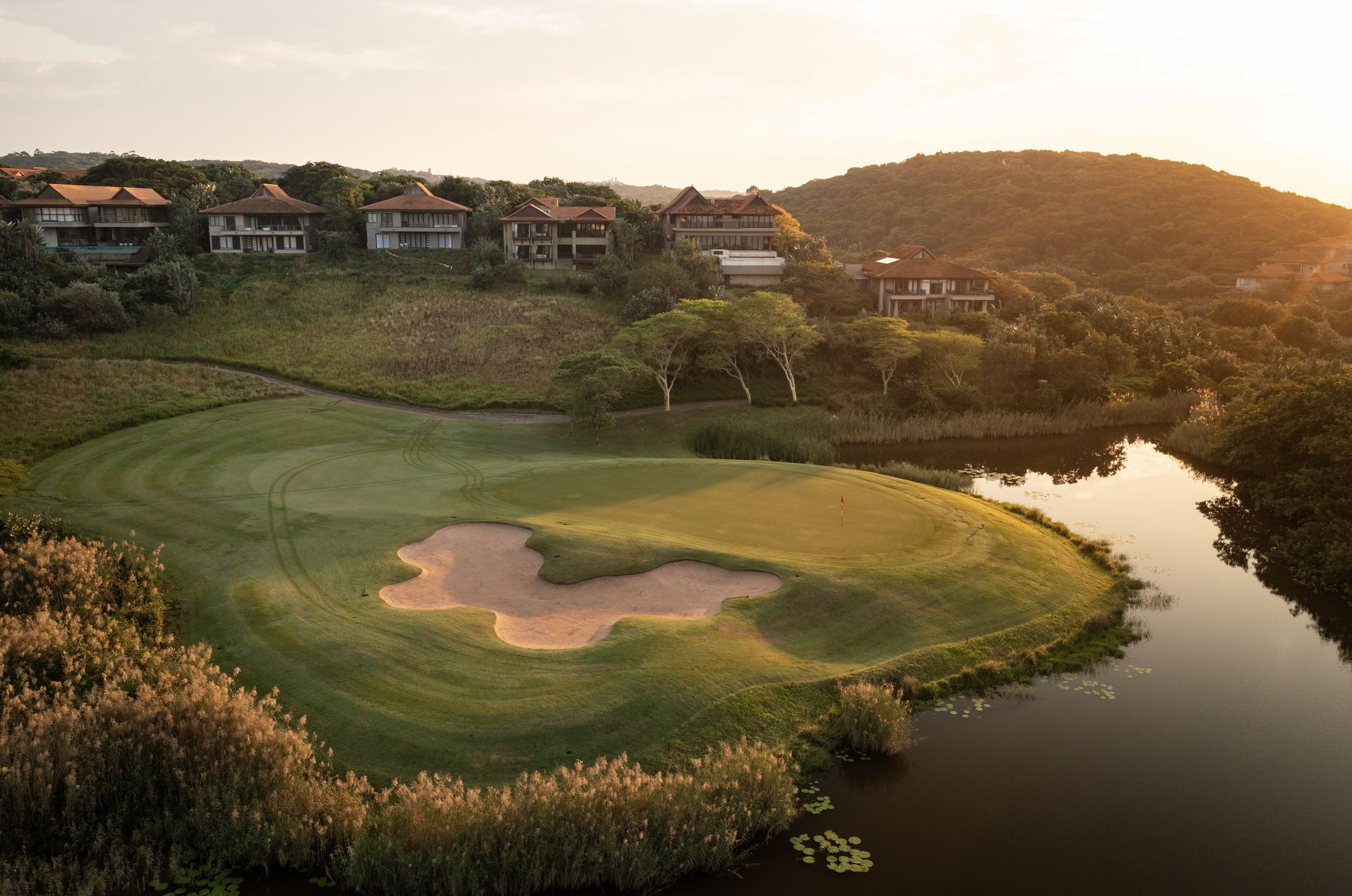
Zimbali has a number of unique and picturesque holes to choose from. One such hole that is always a firm favourite is the par-three 5th. It is the first par three on the card and is hard to beat when it comes to aesthetics and beautiful views. Playing from an elevated tee, the semi-island green below is an intimidating target.
Beyond the hole is the stunning Fairmont hotel and then the warm Indian Ocean yonder. It really is the best view on the entire course. At the same time, it manages to sum up the golf at Zimbali. A visual banquet around every corner but the need for accuracy is an absolute necessity.
As you are so elevated and playing directly towards the ocean, a cross wind of sorts will likely be experienced. At 167m in length, a well-struck iron is required, even though you can take one club off due to the drop in elevation it may not be the best idea.
If the flag is towards the back of the green, water left and a bunker right await a mis-struck shot. There is no real bail-out area and simply aiming for the middle of the green would be the safe play. The good news is as it is the 5th hole you will have a good idea of the wind strength and direction. Taking this into account, choosing the right club based on the distance and ignoring the change in elevation is good advice.
Swing easy, with the ball slightly back in your stance to keep the ball down and reduce the effect of the wind. Slightly short is never a bad thing on this hole as anything long is in trouble. Remember to enjoy the view one last time before leaving the tee box.
The green itself doesn’t have any nasty slopes and makes for a good two-putt opportunity if the surface is found. A great short hole that makes up a strong quartet of par threes on this Tom Weiskopf layout.
GREENFEES
Members
R180/9, R295/18
Guests
Member guest: R300/9, R495/18
Hotel guest: R450/9, R780/18
Golf cart
R240/9, R430/18
GETTING THERE
Take the N2 north of Durban. Take the Ballito Drive off-ramp and after about a kilometre take a right onto the R627. After about 1.5km take a left at the traffic circle and enter the estate.
ROAD DISTANCES
Pretoria: 669km
Bloemfontein: 678km
Cape Town: 1 678km
ADDRESS
R627, Zimbali Estate
Dolphin Coast, 4399
CONTACT DETAILS
Country club: 032 538 1041
Web: www.zimbali.com
– This article first appeared in the August 2023 issue of Compleat Golfer magazine.


